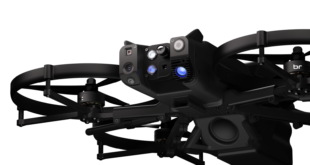Not all police drone footage should be kept secret.
That’s the big takeaway from a California appeals court opinion — thought to be the first of its kind in the nation — that was published this week.
The finding stems from a case filed against the city of Chula Vista in 2021. Arturo Castañares, a Chula Vista resident and the owner and publisher of the bilingual news organization La Prensa San Diego, sued after the city refused to provide footage recorded by the Police Department’s drones.
In April, a San Diego Superior Court judge agreed with the city’s legal position that none of the video had to be released under the California Public Record Act because of an exemption that allows investigative material to remain confidential.
But California’s 4th District Court of Appeal disagreed, stating in its Wednesday opinion that the police drone footage is not automatically exempt from public disclosure.
The ruling could have deep implications as the use of drones by police departments grows. Government transparency advocates and Cory Briggs, Castañares’ attorney, applauded the opinion.
“Given the ubiquity of technology in law enforcement and the growing reliance on drones, it’s important to know how police are deploying these technologies,” Briggs said. “The press and the public had no ability to do that until this ruling came down.”
The Chula Vista Police Department declined to comment on the case since it’s still being litigated.
According to the 29-page opinion, Castañares initially sought access to drone footage from all flights conducted in March 2021 — about 370 calls.
He subsequently qualified the request to exclude any video related to ongoing or pending investigations, on the condition that police provide a log of the videos it planned to withhold.
The city argued that all footage would be considered an investigative record, but the appeals court saw things differently. The opinion acknowledged some videos are certainly investigatory in nature. Those would include all investigations “undertaken for the purpose of determining whether a violation of law may occur or has occurred.” If a violation or potential violation is uncovered, the exemption also extends to investigations conducted to uncover information about that violation.
But that standard may not apply to all of Chula Vista’s videos. The court gave examples including using a drone to look into reports about a mountain lion roaming a neighborhood or a water leak or a stranded motorist on a freeway — all of which could warrant use of the technology without involving a crime or suspected crime.
“We conclude, based on the record before us, the trial court’s broad ruling that all drone video footage, as a matter of law, is categorically exempt because the drones are only dispatched in response to 911 calls was error,” the opinion reads.
As part of its ruling, the appeals court remanded the case back to the trial court so the city could determine how many — if any — of the videos are not related to police investigations and are therefore releasable. The appeals court did not rule on how any of the videos should be categorized.
David Loy, legal director of the First Amendment Coalition, said the finding is an important one in that it supports the understanding — one that has been elucidated by the California Supreme Court before — that the investigatory records exemption in the California Public Records Act applies only to records that are part of a targeted investigation.
“The investigatory records exception is not a blank check to just withhold anything simply because it was generated by law enforcement,” he said.
However, he noted that, separate from the court’s ruling, the investigatory exemption still presents challenges to transparency since it remains very broad and never expires. Once a record is determined to be investigatory and therefore exempt, it is permanently exempt from disclosure, no matter how old the case.
Chula Vista first began exploring the use of drone technology in 2015, establishing a committee to examine its potential applications for policing and to study how an aerial surveillance program would be managed.
By 2018, police officials began a pilot program that had drones — which the city called uncrewed aerial systems, or UAS — launching off department property to respond to calls for service ahead of officers in the field.
Those include emergencies such as fires, crimes in progress and other potential dangers.
“It is important to note that, out of respect for civil liberties and personal privacy, CVPD’s UAS policy specifically prohibits the use of UAS systems for general surveillance or general patrol operations,” the city says on its website.
Chula Vista police say the drones allow trained officials to remotely view the scenes of critical incidents minutes before an officer might arrive. They also allow responders to collect tactical intelligence in advance and view real-time video on cellphones and other platforms, police say.
Castañares said previously that he has no problem with the new technology. But he and others said it is important that the public be granted access to videos collected by police so citizens can feel confident the technology is not being abused.
The city has spent hundreds of thousands of dollars defending its legal position, with expenditures exceeding $300,000 through March 31. The city didn’t not immediately answer how much has been spent on the case since then.
Staff writer Jeff McDonald contributed to this report.
 Unmanned Aerial Vehicle The latest drone news
Unmanned Aerial Vehicle The latest drone news


